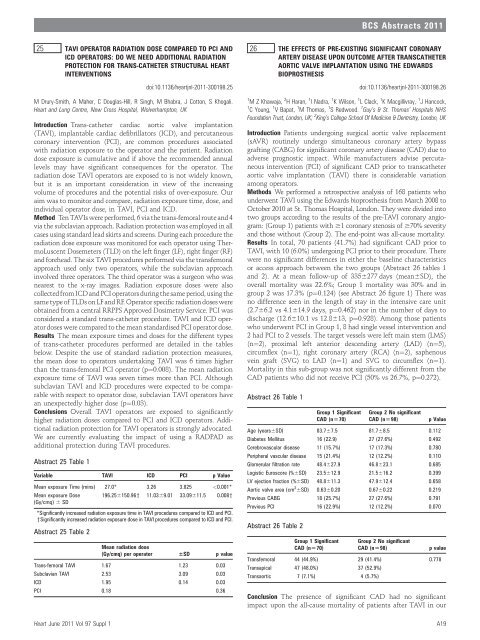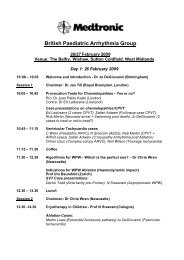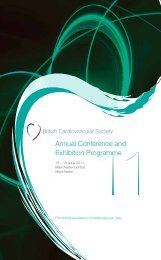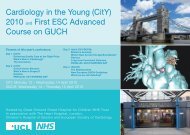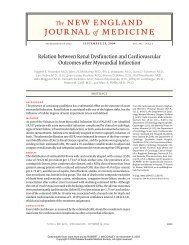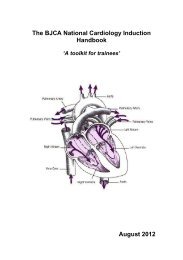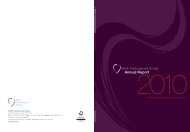Full Supplement - British Cardiovascular Society
Full Supplement - British Cardiovascular Society
Full Supplement - British Cardiovascular Society
Create successful ePaper yourself
Turn your PDF publications into a flip-book with our unique Google optimized e-Paper software.
BCS Abstracts 2011<br />
25 TAVI OPERATOR RADIATION DOSE COMPARED TO PCI AND<br />
ICD OPERATORS: DO WE NEED ADDITIONAL RADIATION<br />
PROTECTION FOR TRANS-CATHETER STRUCTURAL HEART<br />
INTERVENTIONS<br />
doi:10.1136/heartjnl-2011-300198.25<br />
M Drury-Smith, A Maher, C Douglas-Hill, R Singh, M Bhabra, J Cotton, S Khogali.<br />
Heart and Lung Centre, New Cross Hospital, Wolverhampton, UK<br />
Introduction Trans-catheter cardiac aortic valve implantation<br />
(TAVI), implantable cardiac defibrillators (ICD), and percutaneous<br />
coronary intervention (PCI), are common procedures associated<br />
with radiation exposure to the operator and the patient. Radiation<br />
dose exposure is cumulative and if above the recommended annual<br />
levels may have significant consequences for the operator. The<br />
radiation dose TAVI operators are exposed to is not widely known,<br />
but it is an important consideration in view of the increasing<br />
volume of procedures and the potential risks of over-exposure. Our<br />
aim was to monitor and compare, radiation exposure time, dose, and<br />
individual operator dose, in TAVI, PCI and ICD.<br />
Method Ten TAVIs were performed, 6 via the trans-femoral route and 4<br />
via the subclavian approach. Radiation protection was employed in all<br />
cases using standard lead skirts and screens. During each procedure the<br />
radiation dose exposure was monitored for each operator using ThermoLuscent<br />
Dosemeters (TLD) on the left finger (LF), right finger (RF)<br />
and forehead. The six TAVI procedures performed via the transfemoral<br />
approach used only two operators, while the subclavian approach<br />
involved three operators. The third operator was a surgeon who was<br />
nearest to the x-ray images. Radiation exposure doses were also<br />
collected from ICD and PCI operators during the same period, using the<br />
same type of TLDs on LFand RF. Operator specific radiation doses were<br />
obtained from a central RRPPS Approved Dosimetry Service. PCI was<br />
considered a standard trans-catheter procedure. TAVI and ICD operator<br />
doses were compared to the mean standardised PCI operator dose.<br />
Results The mean exposure times and doses for the different types<br />
of trans-catheter procedures performed are detailed in the tables<br />
below. Despite the use of standard radiation protection measures,<br />
the mean dose to operators undertaking TAVI was 6 times higher<br />
than the trans-femoral PCI operator (p¼0.008). The mean radiation<br />
exposure time of TAVI was seven times more than PCI. Although<br />
subclavian TAVI and ICD procedures were expected to be comparable<br />
with respect to operator dose, subclavian TAVI operators have<br />
an unexpectedly higher dose (p¼0.03).<br />
Conclusions Overall TAVI operators are exposed to significantly<br />
higher radiation doses compared to PCI and ICD operators. Additional<br />
radiation protection for TAVI operators is strongly advocated.<br />
We are currently evaluating the impact of using a RADPAD as<br />
additional protection during TAVI procedures.<br />
Abstract 25 Table 1<br />
Variable TAVI ICD PCI p Value<br />
Mean exposure Time (mins) 27.0* 3.26 3.825


